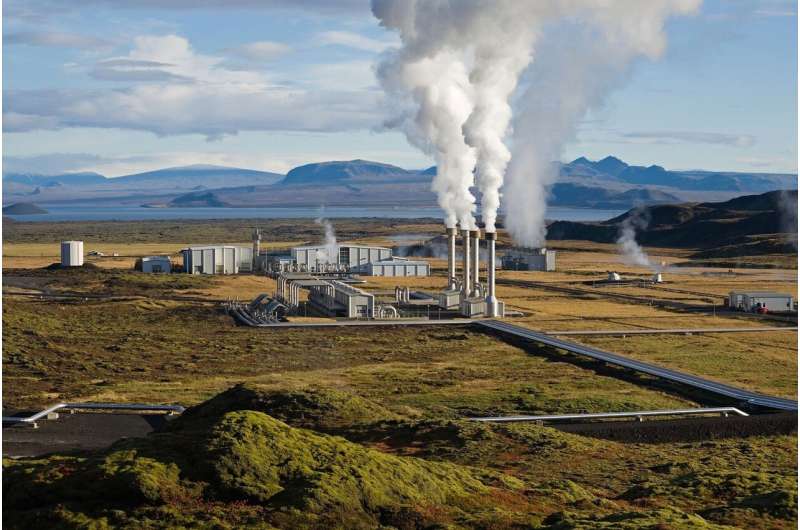This article has been reviewed according to Science X's editorial process and policies. Editors have highlighted the following attributes while ensuring the content's credibility:
fact-checked
reputable news agency
proofread
State assesses geothermal, hydrogen power to help make Colorado 100% renewable

Colorado's goal is to get to 100% renewable energy by 2040, and state officials are looking to geothermal and hydrogen power as important pieces of making the transition.
New state reports say geothermal and hydrogen offer significant opportunities to build on the energy provided by wind, solar and batteries as the state, utilities and communities strive to reduce the effects of climate change. The reports review the potential for tapping more of the energy sources in Colorado as well as the benefits, challenges, economics and mechanics.
The newly released analyses are one of the steps laid out by the Colorado General Assembly in an effort to increase the use of renewable energy sources.
Another was expansion of the former Colorado Oil and Gas Conservation Commission's duties to include regulation of geothermal energy. The agency, renamed the Colorado Energy and Carbon Management Commission, has proposed rules for what is expected to be a growing industry in the state. The first hearing is Aug. 5.
"We're going to be 80% renewable by 2030 and 100% by 2040," Gov. Jared Polis said.
Solar and wind will always be the workhorses in the quest to move from fossil fuels, Polis said. But once fuel sources reach roughly the mark of 85% renewables, there will be a need for "firm, 365-day, 24-hour supply" to replace natural gas, he added.
"It's playing around in that 10% to 20% that we need to be above and beyond solar, storage and wind," Polis said.
New, smaller nuclear power generators are being advanced in some quarters as a possibility.
Polis is especially bullish on geothermal. "There's enormous potential, largely because of our seismology. We happen to have great subsurface heat in Colorado."
In his term as chairman of the Western Governors' Association, Polis led an initiative encouraging geothermal development in the West. The group's report "The Heat Beneath Our Feet" said the U.S. accounts for 25% of the world's installed geothermal energy capacity and the West contains 95% of that capacity.
According to the new state report, the areas in Colorado with the highest potential for producing electricity from geothermal resources, due to the high temperatures of underground water, are: the Upper Arkansas Valley, Raton Basin, Piceance Basin, San Juan Basin, and a spot in the Denver Basin in the eastern part of the state.
While most of the state east of the Front Range has the lowest estimated thermal resource, methods can be used to make geothermal work there, too, the report said. Colorado has long drawn on its many thermal springs for direct geothermal energy. Pumps tap underground heat to both heat and cool buildings.
Will Toor, executive director of the Colorado Energy Office, said the response to the state's geothermal grant program was heartening. The state awarded $7.7 million in grants in May to 35 projects across the state.
Denver company Gradient Geothermal received $100,000 to assess the feasibility of developing a thermal energy network by converting oil and gas operations in the Pierce area in eastern Colorado. Toor said grants will be used for preliminary studies into using geothermal for electricity in Steamboat Springs and at the University of Colorado-Boulder.
"To get the funding, they had to show a pathway to financing" for the projects, Polis said.
Geothermal companies have explored working with oil and gas operators in Colorado and other Western states to use geothermal resources to generate electricity. Oil and gas wells are sometimes repurposed to draw water for plants where hot liquids drive generator turbines.
Toor said oil and gas fields in northeastern Colorado could also be good places for geothermal resources. "There is a significant possibility of oil and gas workers taking the skills they have today and using them in geothermal electricity production, even in similar locations."
While Polis is also excited about using hydrogen as a carbon-free fuel, he acknowledged that there is some controversy around the resource.
Hydrogen is viewed as a way to "decarbonize" shipping, steel-making and other heavy industrial uses. Hydrogen is used in petroleum refining, to make fertilizer, in rocket fuel and to power vehicles.
Some of the controversy around hydrogen stems from the fact that most of what is currently used comes from fossil fuels. NovoHydrogen, a startup in Golden, produces "green" hydrogen, which uses renewable energy to power electrolysis, a process that splits water into hydrogen and oxygen.
The U.S. Department of Energy selected NovoHydrogen to participate in one of seven regional hubs for the development of hydrogen as an energy source. The federal Inflation Reduction Act contains tax credits for green hydrogen projects.
Xcel Energy-Colorado proposed blending hydrogen with natural gas in its plants to decrease emissions and potentially burn 100% hydrogen.
Polis said hydrogen, like natural gas, can be volatile chemically, but in different ways. The state, utilities and companies will have to explore what changes might be needed to existing pipelines to ensure safe shipment of hydrogen.
"We're getting data, the science around exactly what we need to do to make it a safe or safer than natural gas," Polis said.
2024 MediaNews Group, Inc. Distributed by Tribune Content Agency, LLC.















